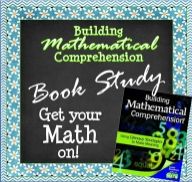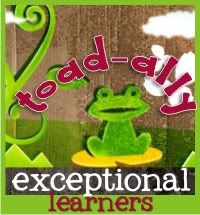Okay, I'm back and ready to talk about Chapter 2 of this fabulous book. I'm loving it, aren't you?
If every chapter is like the first two we are going to be talking about this book for quite some time.
I hope you've had a chance to visit the other hosts for this chapter, Still Teaching After All These Years and My Second Grade Journal. And have you seen how many people have linked up already? (Scroll to the bottom of this post!) Maybe I'll wait a day or two from now on, reading through the other's posts have really helped me cement my own ideas.
Alright, on to the chapter- Recognizing and Understanding Mathematical Vocabulary.
I have always made this a priority in my math class because when I first started teaching math not so long ago I came to it from the perspective as a literacy teacher and it helped me feel more comfortable using strategies I was familiar with...little did I know it was such a good thing!
As I started to read through this chapter the first thing that came to mind, and which actually comes to mind no matter what subject I am planning for or thinking about is- How do we help students who lack the vocabulary they need? Sammons cites many references and studies that show students with a greater vocabulary do better in school and I'm sure this isn't new information for most of us. The question is- how do we help?
Thankfully I kept reading the chapter and found out!
I especially liked on page 46 when Sammons states that "we should consider every student a mathematics language learner regardless of his or her level of English language proficiency." This is something I have noticed in my classroom firsthand. All students require support when dealing with the vocabulary that comes with learning mathematics.
Sammons goes on to talk about Direct Vocabulary Instruction and 8 research-based characteristics! Wow..that was good reading. I am excited to start planning ways to teach more math vocabulary next year and to involve my students in the process. One of the eight research-based characteristics calls for students to "represent their knowledge of words in linguistic and nonlinguistic ways" (page 50). I can imagine a colourful display or colourful math journal pages filled with math vocabulary drawings!
Another of the eight characteristics calls for students to have the opportunity to play with words. Wouldn't this make for a great math workshop rotation? Combine Word Work from The Daily 5 with math! Oh the possibilities!!
I loved, loved, loved that Sammons discussed Marzano and Pickering's six-step process for teaching new words! (page 53). I can see that this page will be viewed again and again by me as I plan for math vocabulary instruction in the future. Perhaps a planning template is needed as well? :) I was gratified to read that sometimes it's good to teach the vocabulary after the concept has already been taught or explored in class as this is often something that I do...isn't nice when you find out you've been doing something right? LOL
Oh...there's so much in this chapter!!
How can I ever post about it all?
I'm going to stop here and come back another day with my thoughts on the remainder of the chapter. This post is already super long and I feel like my head might explode with excitement...and yes, I do know I am a nerd. I've come to embrace it!
I am hoping that you are loving this chapter as much as I am and want to link up with us below!
get the InLinkz code


















































